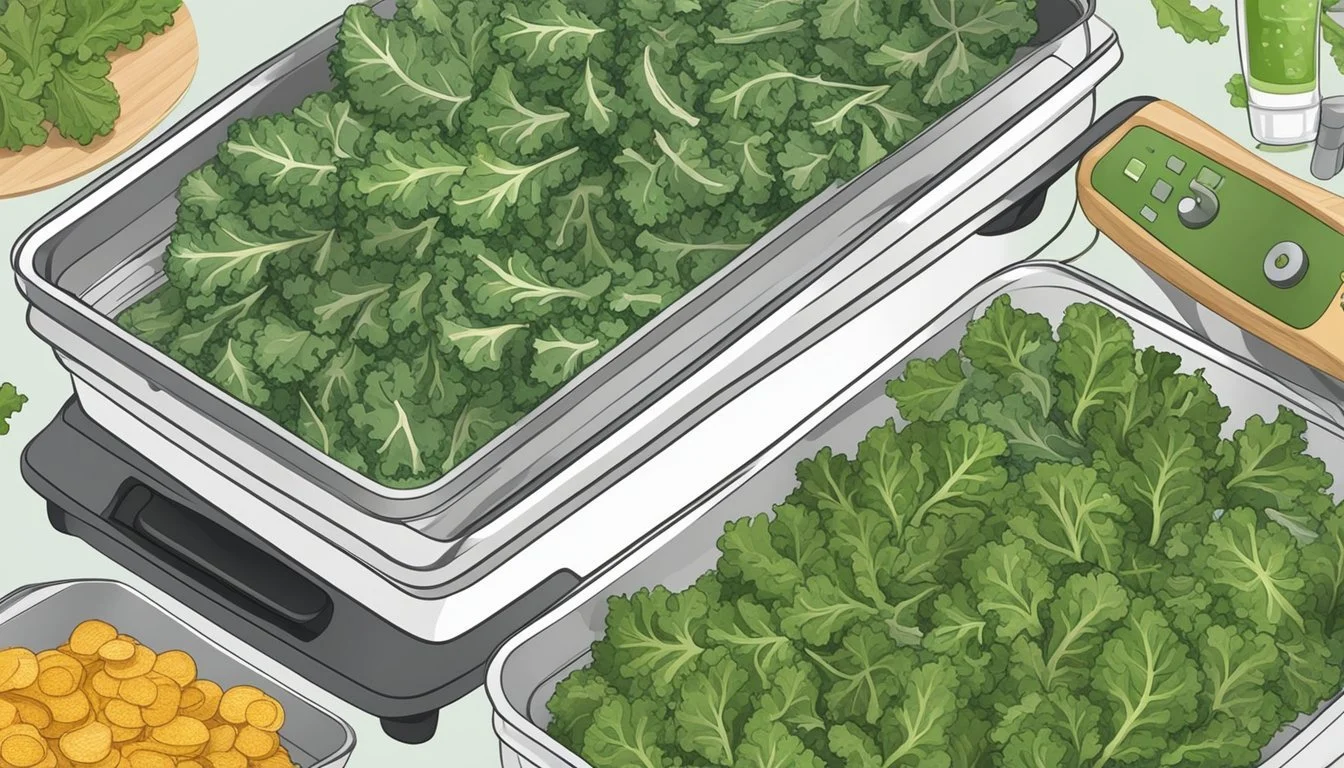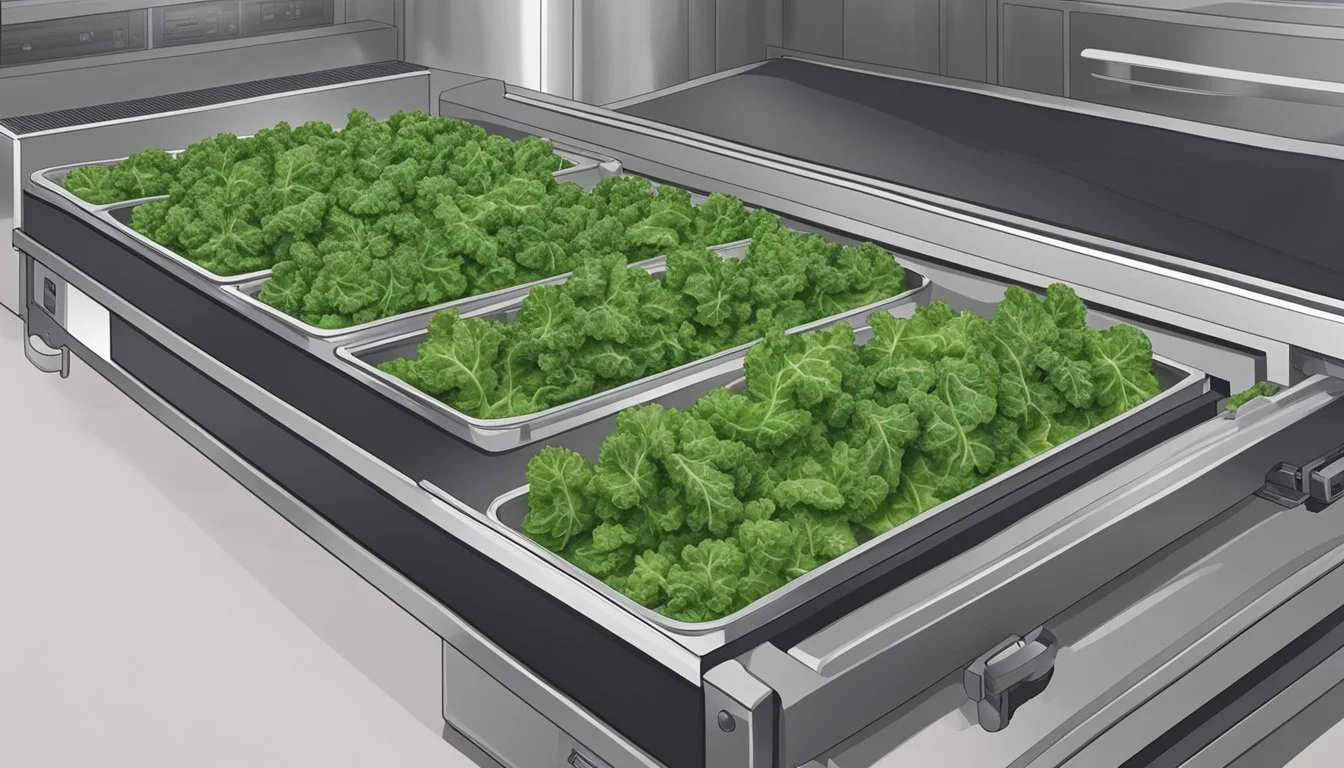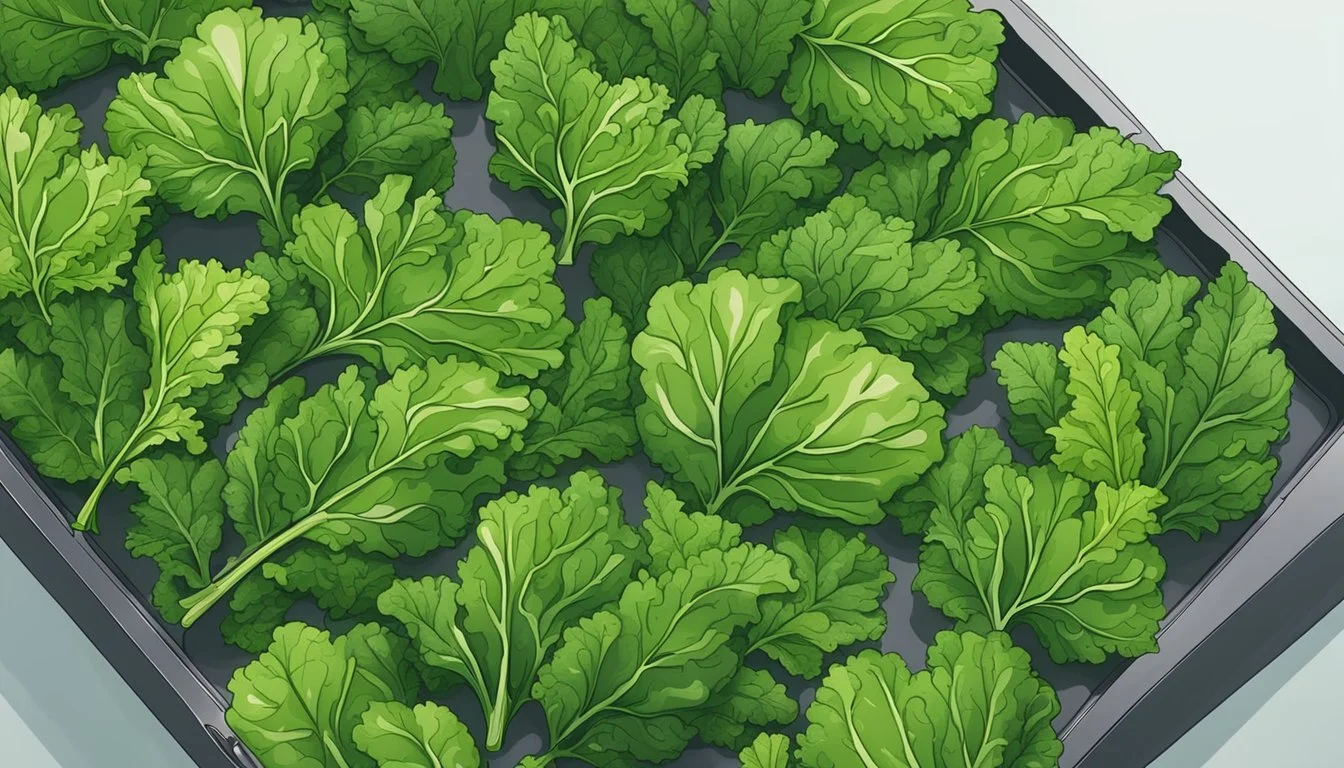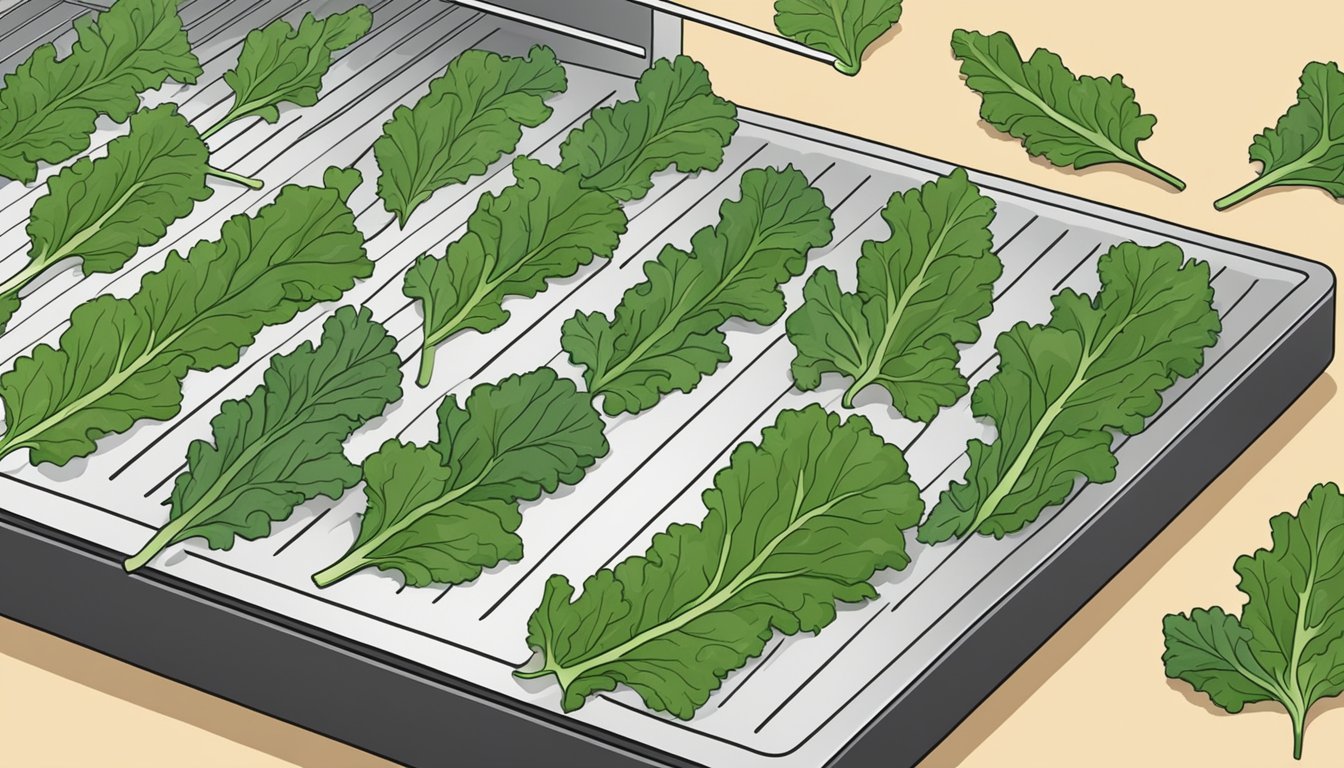How to Dehydrate Kale
A Step-by-Step Guide for Crispy Greens
Dehydrating kale (What wine goes well with kale?) is a simple and effective method to preserve this nutritious green, turning it into a versatile superfood that can be enjoyed year-round. Kale, known for its high nutrient content, including vitamins, minerals, and fiber, makes an excellent candidate for dehydration. By removing moisture from the leaves, one not only extends the shelf life of kale but also concentrates its flavor, making it a perfect addition to a variety of dishes.
The process of dehydration can be achieved through several methods, such as using a dehydrator, an oven, or air-drying. Each method maintains the integrity of kale’s nutrients while transforming the leaves into a crunchy snack or a ready-to-use ingredient for soups, stews, and smoothies. The benefits of dehydrating kale include the convenience of having healthy greens available at any time and the reduction of food waste by preserving the leaves before they wilt.
Kale flakes or chips can easily be incorporated into daily meals, ensuring a regular intake of this superfood. The dehydrated form not only locks in the nutritional benefits but also provides an easy storage solution, as kale can be kept for months without refrigeration once properly dried and stored in an airtight container. With dehydration, kale becomes a staple pantry item, ready to enhance the nutritional value of meals with its dense array of vitamins and minerals.
Preparation of Kale Chips
Kale chips are absolutely delicious and a great way to slip leafy greens into your diet as a healthy snack.
Before dehydrating kale, proper preparation ensures the highest quality finished product. The process involves selecting the best leaves, thoroughly washing them, and prepping them for the dehydration process.
Selecting Quality Kale
One should select fresh, vibrant leaves of kale for dehydration. Opt for organic if possible to avoid pesticide residue. Varieties like dinosaur kale (lancinato kale) are excellent leafy greens due to their texture and flavor.
One must avoid wilted or yellowed leaves as these can affect the taste and nutrient quality of the dehydrated kale.
Washing and Cleaning
To ensure the kale is free from contaminants, one should thoroughly wash the leaves under cold running water. It is essential to remove any dirt or debris which may be clinging to the leaves.
After washing, it is crucial to pat the leaves dry on parchment paper with a paper towel or use a salad spinner to remove excess moisture, as this can impact the drying time and quality.
Removing Stems and Chopping
The kale's tough stems are not optimal for dehydrating; they should be removed. One can easily strip the leaves from the stems using a knife or by hand.
After destemming, chopping the kale into chip-sized pieces ensures even dehydration. Uniformity in size helps in achieving consistent drying throughout all pieces of kale.
Kale Drying Methods
To effectively dehydrate kale, it's essential to utilize methods that encourage even air circulation and maintain the proper temperature settings. The key to retaining nutritional value is gentle drying through controlled heat.
Using Dehydrator Trays
A food dehydrator is an optimal choice for dehydrating kale. One begins by preheating the dehydrator to the lowest temperature setting, typically around 95-115°F (35-46°C).
The kale leaves, after being thoroughly washed and dried, should be arranged on the trays in a single layer to ensure consistent airflow.
The leaves are then dehydrated until they become dry and crisp, which usually takes between 4 to 8 hours, depending on the dehydrator's efficiency and the kale's moisture content.
Oven Drying Method
For those without a dehydrator, an oven can be a suitable alternative. Preheat the oven to the lowest temperature setting to mimic a dehydrator's environment; many ovens have a setting around 170°F (77°C) or "Keep Warm" mode.
Remove the kale's central stem and place the leaves on a baking tray in a single layer. The kale should remain in the oven until it's fully dried, which can take around 2 to 4 hours.
It's crucial to keep the oven door slightly ajar to allow moisture to escape and to check the kale regularly to prevent burning.
Seasoning Homemade Kale Chips
Before dehydrating kale to create crispy kale chips, one can enhance their snack by adding a variety of seasonings and flavors.
The process allows the kale to not only take on the desired crispness but also lets it absorb the rich flavors of seasonings for a tastier experience.
Adding Oil and Salt
One can begin by lightly tossing kale pieces in a small amount of olive oil. This not only help the kale to crisp up in the dehydrating process but also enables salt and other seasonings to stick to the leaves. For those looking to keep their snack simple, a sprinkling of sea salt (how long does sea salt last?) may suffice.
Olive oil: A drizzle
Salt: To taste, before the dehydration
Using Spices and Seasonings
To elevate kale chips beyond their natural flavor, a mix of spices can be used. Here is a simple table of popular seasonings one can consider:
Seasoning Suggested Use Cayenne pepper A light dash for a spicy kick Garlic powder (how long does garlic powder last?) A sprinkle for a savory note Curry A teaspoon for an exotic tinge Nutritional yeast (how long does nutritional yeast last?) A tablespoon for a cheesy flavor and added nutrients
One can apply these seasonings after oiling, ensuring an even distribution for a consistent taste in every bite. The combination of these flavors can transform plain kale into a delicious, nutritious snack that is both savory and indulgent.
Proper Dehydration Technique
Dehydrating kale requires attention to detail, from arranging the leaves carefully to ensuring consistent drying throughout the process.
Layering on Dehydrator Trays
One must arrange the kale in a single layer on the dehydrator trays to promote proper air circulation. Overlapping can lead to uneven dehydration and potentially moist, chewy spots on the leaves.
The leaves should not touch to ensure that air can circulate each piece, enabling uniform drying.
Monitoring the Process
While the kale dehydrates, it’s important to monitor the progress. Set the dehydrator to a low temperature—typically around 125°F—to preserve the kale's nutrients.
A kale leaf is considered fully dehydrated when it is dry and crispy to the touch, which usually takes about 4-6 hours. One should check the kale periodically, rotating the trays if necessary, to ensure even dehydration.
Dehydrated Kale Chips Storage Solutions
Proper storage is essential for maintaining the quality of dehydrated kale chips. Here are the specifics for ensuring its longevity and preserving its nutrient content.
Cooling Down
After kale is dehydrated, it's crucial to allow it to cool down completely at room temperature. If the kale is stored while still warm, condensation can occur, leading to moisture in the storage container, which can cause spoilage.
Storing Dehydrated Kale Chips in Containers
Once cool, dehydrated kale should be transferred to airtight containers. These containers keep out moisture and air, preserving the kale's crispness and nutritional value.
It's best to store the containers in a cool, dark place to protect the kale from light and heat, which can degrade its quality over time. If stored correctly, dehydrated kale can last several months.
Uses for Dehydrated Kale
Dehydrated kale offers versatility in the kitchen, retaining its vibrant color and nutrient density. It can be used in various forms, including chips and powder, and incorporated into many recipes from soups to smoothies.
Making Kale Chips
One can transform dehydrated kale into crispy kale chips by seasoning the leaves before the dehydration process.
This creates a healthy snack with a satisfying crunch and a texture similar to traditional potato chips (how long do potato chips last?) but with fewer calories and more nutrients.
The best kale chips are homemade, it is easy to make kale chips and the recipe can be tweaked to your preference with cajun seasoning, cayenne pepper or chili powder, nutritional yeast, and garlic powder.
A basic recipe to make kale chips involves;
Ingredients: Dehydrated fresh kale leaves, extra virgin olive oil, sea salt.
Instructions:
Lightly coat the kale leaves with extra virgin olive oil.
Sprinkle with sea salt.
Dehydrate until the dried kale chips (how long do dried kale chips last?) reach the desired level of crispiness.
Creating Kale Powder
Kale powder is made by grinding completely dry dehydrated kale into a fine powder.
The resulting kale powder is a concentrated source of vitamins and can be used to boost the nutritional content of meals. A food processor helps to make the chip-sized pieces into a powder.
Uses:
Sprinkling on foods for a super-healthy extra nutrient kick.
Incorporating into spice blends.
Inclusion in Recipes
Dehydrated kale can be added directly to recipes for an infusion of color, texture, and flavor. It is particularly popular in:
Soups & Stews: Adds richness and a slight thickness.
Salads: Provides an appealing crumble and chewiness.
Smoothies: Boosts nutritional value without altering the drink's consistency.
Utilizing dehydrated kale can elevate the nutritional profile and visual appeal of dishes with its versatility and durable storage properties.
Nutritional Benefits
Dehydrated kale offers a wealth of nutritional benefits, retaining its rich vitamin and mineral content while being a low-calorie, low-fat, and high-protein snack option.
Vitamins and Minerals
Dehydrated kale is a powerhouse of essential vitamins and minerals. It's notably high in Vitamin K, critical for blood clotting and bone health.
Additionally, kale is a good source of Vitamin A, promoting eye health, and Vitamin C, an important antioxidant that aids in immune function and skin health.
The leafy green also provides a generous supply of minerals such as calcium, potassium, and magnesium, all of which have vital roles in bodily functions.
Vitamin A: Critical for vision, immune system, and reproduction
Vitamin C: Antioxidant that helps protect cells from damage
Vitamin K: Essential for blood clotting and bone metabolism
Calcium: Necessary for bone health and muscular function
Potassium: Contributes to proper nerve and muscle function
Magnesium: Involved in over 300 biochemical reactions in the body
Calories, Fat, and Protein
When kale is dehydrated, it becomes a concentrated source of nutrition with a reduced water content, resulting in a snack that is low in calories and virtually free of fat.
This makes it a healthy choice for those monitoring their calorie intake or seeking weight management options.
Furthermore, kale is a source of plant-based protein, contributing to muscle maintenance and growth, making dehydrated kale not just a nutritious but also a satiating snack.
Calories: Low calorie, suitable for weight management
Fat: Negligible fat content, making it a heart-healthy choice
Protein: Contains plant-based protein for muscle health
The fiber content in kale also aids digestion and can contribute to a feeling of fullness, supporting those who are aiming to control their appetite.
Considering the nutritional value of kale, it is evident that its dehydrated form is not only convenient but also preserves most of the antioxidants and nutrients found in the fresh leaves.
Conclusion
Dehydrating kale is a convenient method to preserve this nutrient-rich vegetable while extending its shelf life.
Those who enjoy homemade kale chips can benefit significantly from this preservation technique, as it allows them to create a savory snack that aligns with health-conscious diets, including paleo.
By following a simple process of washing, drying, and chopping, anyone can make kale chips at home.
A food dehydrator or oven set at a low temperature between 125°F to 135°F is typically used to ensure even and thorough drying. The key indicator of properly dehydrated kale is its crispness; the leaves should snap easily when bent.
The final product not only serves as a delightful treat but also can be stored easily and kept on hand as a versatile ingredient for various culinary applications.
It's important to cool the dehydrated kale completely before storing it in an airtight container to maintain its freshness.
Moreover, making a batch of dehydrated kale chips at home can be more cost-effective compared to purchasing pre-packaged options, and it offers the flexibility to customize flavors to one's liking.
In summary, dehydrating kale is a straightforward and practical approach to preserve its natural goodness while ensuring that one can enjoy its benefits for an extended period whether you are preserving your own kale or store-bought.






